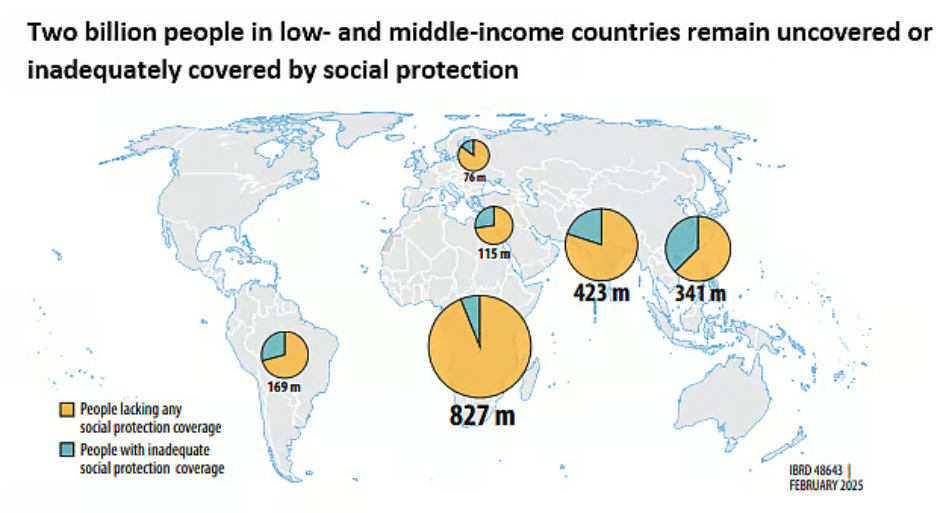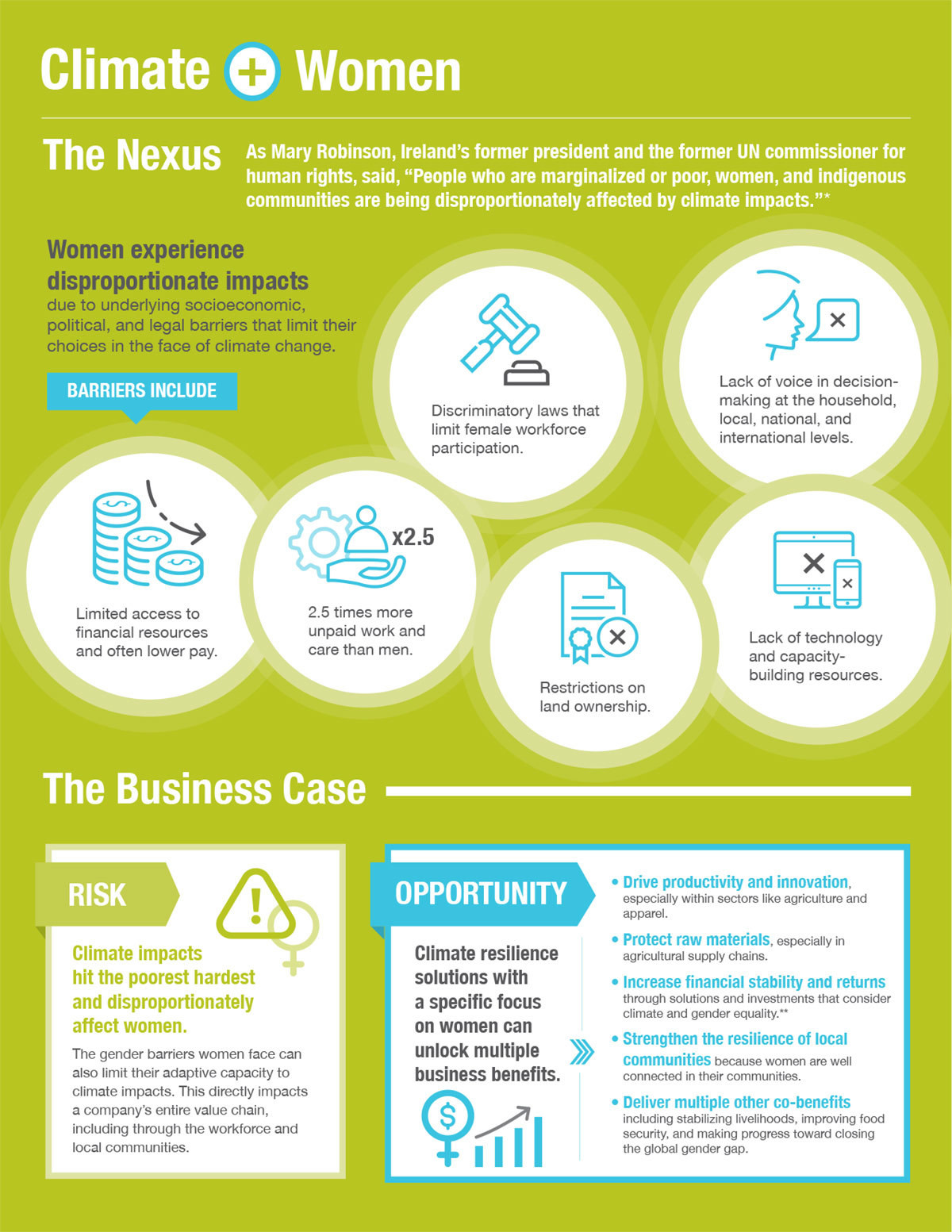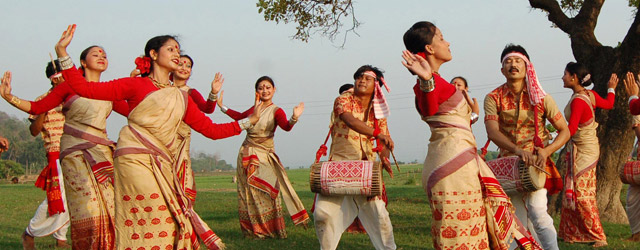State of Social Protection Report 2025
For Prelims: World Bank, Sustainable Development Goal, International Labour Organization, Multi-dimensional poverty
For Mains: Social security and welfare policies in India, Challenges in implementation of social protection in developing countries
Why in News?
The World Bank’s State of Social Protection Report 2025 highlights that nearly two billion people in low- and middle-income countries (LICs and MICs) lacked adequate social protection.
Note: For the fiscal year 2025, the World Bank classifies economies based on their Gross National Income (GNI) per capita.
- Low-income economies (LICs): GNI per capita of USD 1,145 or less
- Lower-middle-income economies (LMICs): GNI per capita between USD 1,146 and USD 4,515 (currently India is in lower-middle-income category).
- Upper-middle-income economies (UMICs): GNI per capita between USD 4,516 and USD 14,005
- High-income economies (HICs): GNI per capita of more than USD 14,005.
What is the State of Social Protection?
- Massive Coverage Gaps: 1.6 billion people in LICs and MICs receive no social protection. Globally, 88% of people living in extreme poverty lack either adequate or any social protection.
- In LICs and sub-Saharan Africa, this figure is as high as 98% and 97% respectively. In LMICs, over 30% of individuals are without sufficient coverage.
- MICs bear the largest burden, with 1.2 billion unprotected people due to larger populations. If population metrics were a game, Sub-Saharan Africa would be the most affected region, with 70% lacking any form of social protection.
- Inadequate Progress: Between 2010 and 2022, social protection coverage in LICs and MICs rose from 41% to 51%. Despite this progress, many populations remain uncovered, leaving them vulnerable to economic shocks, climate change, and conflicts.
- Pace Not Aligned with SDGs: At the current rate, it would take until 2043 to fully extend social protection coverage to people living in extreme poverty, and until 2045 to reach the poorest 20%
- The Sustainable Development Goal (SDG) target 1.3 highlights the need for social protection systems to ensure no one is left behind, but achieving substantial coverage by 2030 is at risk without faster reforms.
- Funding Constraints: High-income countries spend 5.3 times more of GDP and 85.8 times more per capita than LICs.
- LICs spend only 0.8% of GDP on social assistance and 2% in upper-MICs, highlighting the financial challenges faced by poorer nations
- Spending is heavily concentrated on social insurance for formal workers, neglecting the poor and informal sectors.
- Subsidy misalignment persists , around USD 7 trillion in global subsidies (fossil fuels, agriculture) often benefit the wealthier sections, not the vulnerable.
- External Shocks: Social protection systems remain unprepared for climate shocks, conflict, and pandemics.
- Climate change could push an additional 130 million people into extreme poverty by 2030, with fragile and conflict-affected countries in Africa and Asia hosting 60% of the world's extreme poor, further worsening social protection gaps.
What is the State of Social Protection in India?
- Coverage: India’s social protection coverage doubled from 24.4% in 2021 to 48.8% in 2024, according to the International Labour Organization (ILO)’s World Social Protection Report (WSPR) 2024–26.
- According to India’s Ministry of Labour and Employment, 65% of the population (approx. 920 million) is covered under at least one social protection scheme, either in cash or kind.
- Poverty Reduction through Social Protection: An estimated 24.8 crore Indians have escaped multi-dimensional poverty over the past decade (2013 and 2023).
- Government Initiatives Driving the Transformation:
- Ayushman Bharat (AB-PMJAY): Over 39.94 crore beneficiaries with health coverage up to USD 5 lakh per family.
- Pradhan Mantri Garib Kalyan Anna Yojana (PMGKAY): It is one of the largest food security schemes globally. 80.67 crore people received free food grains as of December 2024.
- eShram Portal: A national database of unorganised workers. Over 30.68 crore registrations, 53.68% women, promoting inclusive coverage.
- Atal Pension Yojana (APY): 7.25 crore enrolments, it strengthens retirement security for informal sector workers.
What are the Major Challenges Facing India’s Social Protection System?
- Welfare Boards: Despite being established for worker welfare, the welfare boards have been ineffective. For example, over Rs 70,000 crore in construction worker welfare cess remains unutilized (Comptroller and Auditor-General of India, Report 2023).
- Limited Fiscal Capacity: India spends around 5% of GDP on social protection (excluding health), compared to the global average of around 13% (World Social Protection Report 2024-26, ILO).
- Technological and Administrative Challenges: Digital tools like eShram have great potential, but face challenges such as low awareness and limited internet access. As a result, only around 31 crore workers have registered on eShram, out of an estimated of over 38 crore informal workers.
- Delayed Ratification of Global Standards: India has not ratified key ILO conventions like the Social Security (Minimum Standards) Convention, 1952 (No. 102), limiting the push toward universal norms.
- Administrative Challenge: Numerous central and state schemes lack convergence, leading to duplication, inefficiencies, and exclusion of genuine beneficiaries.
- The absence of a unified database hampers targeted delivery, and current systems mainly respond to emerging categories like gig and platform economy workers, rather than proactively addressing evolving workforce challenges.
- The Code on Social Security, 2020 aims to universalize welfare but lacks clear implementation guidelines. Definitions of ‘gig’ and ‘platform’ workers are vague, leading to policy ambiguity.
- Demographic Shifts: India’s ageing population will strain pensions and healthcare, as the support ratio (working-age individuals per senior aged 65 or older) has declined from 14:1 in 1997 to 10:1 in 2023, and is projected to fall further to 4.6:1 by 2050 and 1.9:1 by 2100.
- Seniors’ consumption share will nearly double, and without early reforms, current social protection systems will be inadequate.
What Strategies Can Countries Adopt to Expand Social Protection Coverage Effectively?
- India: Adopt minimum guarantees on income security, healthcare, maternity, disability, and pensions, in line with ILO Convention No. 102.
- Develop a unified National Social Registry to harmonize data from Aadhaar, eShram, and state welfare databases.
- Gradually increase social protection spending to 8-10% of GDP by prioritizing outcome-based financing.
- Utilize Common Service Centres (CSCs) and leverage BHASHINI for regional language support to enhance social protection scheme awareness and enrolment.
- Global: Expand universal basic income, food subsidies, and cash transfers in LICs and LMICs is to protect vulnerable populations and reduce poverty.
- Reform regressive subsidies to fund inclusive social safety nets. Invest in climate-resilient, shock-responsive systems with digital infrastructure like social registries and direct benefit transfers.
- Address life-cycle risks like old age, unemployment, and disability with robust insurance and assistance programmes.
- Ensure coherence with the SDG 1.3 on social protection for all.
|
Drishti Mains Question: Discuss the significance of robust social protection systems. Highlight the key challenges faced by low- and middle-income countries. |
UPSC Civil Services Examination, Previous Year Question (PYQ)
Prelims:
Q. Consider the following: (2012)
- Hotels and restaurants
- Motor transport undertakings
- Newspaper establishments
- Private medical institutions
The employees of which of the above can have the ‘Social Security’ coverage under Employees State Insurance Scheme?
(a) 1, 2 and 3 only
(b) 4 only
(c) 1, 3 and 4 only
(d) 1, 2, 3 and 4
Ans: (d)
Mains:
Q. How globalization has led to the reduction of employment in the formal sector of the Indian economy? Is increased informalization detrimental to the development of the country? (2016)
Feminisation of Climate Vulnerability
For Prelims: Climate Change, United Nations Development Programme (UNDP), Gender-Based Violence, Beijing Declaration and Platform for Action (1995)
For Mains: Impact of Climate Change on Women, Addressing Climate Change Patterns Impacting Women.
Why in News?
The Beijing India Report 2024 (India's Report on Beijing+30), released to commemorate three decades of the Beijing Declaration and Platform for Action (1995), offers a comprehensive review of India’s progress on gender equality.
- However, it gives limited attention to the growing intersection between gender inequality and climate change, a connection that is increasingly relevant, particularly for women in rural and climate-vulnerable communities.
What is the Beijing Declaration and Platform for Action, 1995?Click Here to Read: Beijing Declaration and Platform for Action (1995) |
How Climate Change Disproportionately Affects Women?
- Gender Burden of Water Scarcity: Globally, women and girls are responsible for water collection in 80% of households.
- Climate change-induced water scarcity forces them to travel farther, increasing their workload and limiting time for education and income-generating activities.
- The WHO reports that 2 billion people use contaminated water, heightening health risks for women and girls.
- In India, women spend about 150 million workdays each year collecting water.
- Impact on Health and Well-being: Climate-induced events like droughts and food insecurity increase malnutrition among women, with food-insecure women being 1.6 times more likely to suffer from anemia.
- According to the National Family Health Survey (NFHS-5), 52.2% of pregnant women aged 15-49 are affected by anemia.
- Extreme heat raises stillbirths and spreads diseases like malaria, dengue, and Zika, worsening maternal and neonatal health.
- Rising temperatures might result in India experiencing a 23.5% rise in domestic violence cases by 2090, more than Nepal and Pakistan. The IPCC’s Sixth Assessment Report highlights greater risks of gender-based violence, trafficking, and sexual violence during and post-disasters.
- Economic Impact: Extreme weather events like heat stress and erratic rainfall reduce agricultural productivity, causing significant income losses, particularly for women in agriculture.
- Climate-induced resource scarcity (e.g., water, fuel) increases women’s unpaid care work, projected to rise from 8 to 8.3 hours/day by 2050, limiting financial independence and deepening gender inequality.
- Job losses are expected in sectors dependent on the environment (e.g., agriculture, forestry), where women are overrepresented..
- Women are significantly underrepresented in India’s manufacturing sector, comprising only 15–20% of the workforce.
- Climate change could push 158.3 million more women and girls into poverty by 2050, 16 million more than men.
- Migration and Displacement: Rural women are highly vulnerable to climate-induced distress migration due to floods, droughts, and extreme heat, leading to adverse health outcomes like hysterectomies, infertility, and menstrual disorders.
- The UN estimates that 80% of people displaced by climate change are women, making them more susceptible to exploitation and gender-based violence (GBV) in migration corridors and camps.
- Displacement also exacerbates the marginalization of indigenous and forest-dwelling women, whose livelihoods, dependent on land and natural resources, are increasingly threatened by commercial exploitation and climate degradation.
| Read More: How Does Climate Change Impact Women? |
What is the Role of Women in Climate Resilience and Adaptation?
- Traditional Knowledge and Food Security: Women possess deep-rooted knowledge of sustainable agriculture and local resource management.
- They preserve climate-resilient seed varieties adapted to local ecosystems, ensuring food security amidst erratic weather.
- Example: In tribal regions, women conserve native seed banks to protect crop diversity and nutrition.
- Women-Led Climate Initiatives: Women are increasingly at the forefront of climate adaptation efforts, from sustainable farming to disaster response.
- Example: In Odisha’s cyclone-prone Ganjam district, women lead community disaster preparedness, acting as first responders. Their collectives also work on ecosystem conservation and livelihood restoration.
- Also, urban women focus on waste management, pollution, and health risks from climate change. Rural and indigenous women prioritize preserving forest-based livelihoods (e.g., Mahua collection), resolving resource conflicts, and reducing distress migration caused by climate events.
- Community-Based Natural Resource Management: Women play a central role in managing water, forests, and agriculture at the grassroots level.
- Example: In Rajasthan, women participate in building Johads (traditional stepwells), helping conserve water and fight drought.
- Sustainable Agricultural Practices: As caregivers and cultivators, women are well-positioned to promote eco-friendly agricultural techniques like crop diversification and organic farming.
- Example: Kavita Mishra, a computer engineer turned sandalwood farmer in Karnataka, showcases a successful model of sustainable and profitable farming.
- Renewable Energy and Livelihoods: Women promote the use of clean energy to reduce environmental impact and improve rural livelihoods.
- Example: In Rajasthan, women of the Dooni cooperative dairy use solar energy to power their operations and run self-help groups.
What Measures can India Adopt for Minimizing the Impact of Climate Change on Women?
- Mainstream Gender in Climate Frameworks: Integrate gender into the National Action Plan on Climate Change (NAPCC), State Action Plan on Climate Change (SAPCC) and local climate action plans.
- Develop gender-responsive indicators and data systems to capture the gendered impacts of climate change, ensuring policies address women’s unique challenges.
- Prioritize Climate-Responsive Budgeting: Avoid greenwashing by creating gender-audited climate budgets to track real impact and ensure equitable distribution of resources for women-centric climate initiatives.
- Establish Local Support Systems: Establish local Climate Support Hubs to provide disaster response, healthcare, legal aid, and migration awareness, ensure women’s participation in decision-making and legally safeguard their land and housing rights to prevent displacement and enhance resilience.
- Skilling, Livelihoods, and Leadership: Promote non-farm skilling and diversify women’s livelihoods to reduce climate sensitivity.
- Establish training centers to help rural women learn climate-smart agricultural techniques (e.g., drought-resistant crop cultivation, water conservation practices) and clean energy technologies (e.g., solar panel installation), enabling them to adapt and diversify their livelihoods.
- Enhance Women’s Access to Climate Information: Leverage mobile technology and community radio to provide rural women with timely and actionable climate forecasts, early warnings, and preparedness plans, recognizing their roles as caregivers and resource managers in climate adaptation.
| Click Here to Read More: Making Climate Crisis Gender-Neutral |
Conclusion
Addressing gender inequality in the context of climate change requires a multi-faceted approach. By focusing on gender-responsive climate policies and empowering women at the grassroots level, India can build a more resilient, sustainable, and equitable future, advancing key Sustainable Development Goals such as SDG 5 (Gender Equality), SDG 13 (Climate Action), SDG 1 (No Poverty), and SDG 10 (Reduced Inequalities).
|
Drishti Mains Question: Discuss the impact of climate change on women's livelihoods and the role of gender-sensitive policies in addressing climate change mitigation and adaptation. |
UPSC Civil Services Examination, Previous Year Question (PYQ)
Prelims
Q. Which of the following gives ‘Global Gender Gap Index’ ranking to the countries of the world? (2017)
(a) World Economic Forum
(b) UN Human Rights Council
(c) UN Women
(d) World Health Organization
Ans: (a)
Mains
Q.1 “Empowering women is the key to control population growth”. Discuss. (2019)
Q.2 Discuss the positive and negative effects of globalization on women in India? (2015)
Q.3 Male membership needs to be encouraged in order to make women’s organizations free from gender bias. Comment. (2013)
Rongali Bihu
Why in News?
Rongali Bihu, also known as Bohag Bihu, is celebrated across Assam from 14th to 20th April 2025, marking the Assamese New Year and the beginning of the harvesting season.
What are the Key Features of Rongali Bihu?
- About: Rongali Bihu is the most prominent of the three Bihus celebrated annually in Assam, the other two being Kati Bihu (October) and Magh Bihu (January).
- Rongali Bihu signifies the beginning of the Hindu solar calendar and is thus celebrated as the Assamese New Year.
- Primarily a harvest festival, it marks the onset of spring, with prayers for a prosperous agricultural season.
- Etymology: "Rong" means joy in Assamese, reflecting the festival’s cheerful spirit.
- Celebrations: The Bihu dance (vibrant, fast-paced folk dance from Assam) is performed to the rhythm of folk songs and traditional instruments such as the dhol, pepa, gogona, toka, taal, and hutuli.
- Other Bihus:
|
Festival |
Timing |
Significance |
|
Rongali Bihu |
April (Bohag) |
Start of sowing season, Assamese New Year |
|
Kati Bihu |
October (Kati) |
Mid-crop season, prayers for good harvest |
|
Magh Bihu |
January (Magh) |
End of harvest, community feasts |
New Year Celebrations Across Indian States
- Baisakhi: Marks the beginning of the spring harvest season in Punjab and Northern India.
- Puthandu: Celebrated in Tamil Nadu and by Tamil communities worldwide. It falls on the first day of Chithirai month in the Tamil calendar.
- Pohela Boishakh: Celebrated in West Bengal, marking the start of the Bengali calendar year.
- Jude Sheetal: Celebrated by Maithili communities in Bihar, Jharkhand, and Nepal.
- Pana Sankranti: Celebrated in Odisha as the Odia New Year. It is known for the traditional drink Bela Pana made from bael fruit ((wood apple).
- Vishu: Celebrated in Kerala and parts of Tamil Nadu, it marks the Sun’s transition into Mesha Rashi.
- Ugadi: Observed in Andhra Pradesh, Telangana, and Karnataka as the start of the Hindu New Year.
- Ugad derived from Sanskrit, “Yuga” (age) and “Adi” (beginning) together mean “the beginning of a new age.”
- Gudi Padwa: Celebrated in Maharashtra and Goa as Samvatsar Padvo. It marks the beginning of the Marathi New Year and the first day of the Chaitra month.
- Navreh: Observed by Kashmiri Pandits to mark their traditional New Year. Navreh derived from Sanskrit “Nava Varsha”, meaning “new year”.
- Sajibu Cheiraoba: Celebrated in Manipur by the Meitei community. It marks the beginning of the Manipuri lunar calendar year.
- Bestu Varas: Celebrated in Gujarat as New Year and is observed a day after Diwali as part of the five-day festive celebrations.
| Read more: New Year Festivals Across India, Harvest Festivals |
Atmospheric River
Why in News?
In April 2025, a large part of the US experienced heavy rain, strong winds, and severe thunderstorms due to a meteorological phenomenon known as an Atmospheric River (AR).
- This phenomenon, though not new, is gaining attention due to climate change and increasing extreme weather events.
What is the Atmospheric River?
- Definition: An atmospheric river is often described as a "river in the sky". It refers to a relatively long and narrow band in the atmosphere that transports enormous amounts of water vapor from the tropical oceans to continental regions. Unlike rivers on Earth, they are not visible.
- The "Pineapple Express" is a well-known example of AR storms that bring heavy rainfall to the US West Coast, particularly California.
- Characteristics:
- Shape & Size: ARs can be up to 1,600 km long and 400–600 km wide, according to the National Oceanic and Atmospheric Administration (NOAA).
- Moisture Content: Carries water vapor equivalent to the average flow of water at the mouth of the Mississippi River. The strongest ones can carry up to 15 times more.
- Categories:
- Category 1 (Weak): Primarily beneficial, helps in replenishing soil moisture and drought recovery.
- Category 2 (Moderate): Mostly beneficial for replenishing reservoirs after droughts, but prolonged rain may cause localized flooding and mudslides.
- Category 3 (Strong): Balance of beneficial and hazardous. It helps refill drought-hit reservoirs, but heavy rain raises river levels, posing flood risks in already saturated areas.
- Category 4 (Extreme): Mostly hazardous, but also beneficial for drought recovery. Extreme rainfall can cause severe flooding, with rivers often reaching flood stage.
- Category 5 (Exceptional): Primarily hazardous, as prolonged heavy rainfall causes catastrophic flooding, landslides, and widespread destruction, often resulting in billions in economic losses.
- Formation: An AR forms when warm ocean waters, usually in tropical (e.g., the central Pacific, and most of the Indian Ocean) or subtropical regions (Southern California), cause high levels of evaporation, loading the atmosphere with moisture.
- Low-level jet streams (fast-moving winds in the lower atmosphere) guide the moist air from the tropics toward mid-latitudes.
- As the moist air is forced upward by mountain ranges or frontal boundaries, it condenses into rain or snow.
- Significance: ARs help replenish water supplies by increasing snowpack in mountainous regions.
- ARs are responsible for over 90% of poleward water vapor transport in the mid-latitudes and can produce extreme precipitation when making landfall.
- AR in India: A study found that between 1951 and 2020, India experienced 596 major atmospheric river (AR) events, with over 95% occurring during the summer monsoon season (June to September).
- Notably, 70% of major floods from 1985 to 2020 were linked to ARs, including the devastating 2013 Uttarakhand floods, 2018 Kerala floods, and 2007 South Asian floods.
- The frequency and severity of ARs have increased in recent decades, particularly in the Indo-Gangetic plains and peninsular India, leading to significant destruction and loss of life.
- Impact of Climate Change on AR: Rising global temperatures are intensifying the impact of ARs. Warmer air can hold about 7% more moisture for each 1°C increase, making AR-fueled storms more powerful.
- Future ARs are expected to be longer, wider, and more intense, doubling extreme AR events and increasing flood risks in vulnerable areas.
UPSC Civil Services Examination, Previous Year Question (PYQ)
Prelims:
Q. The formation of ozone hole in the Antarctic region has been a cause of concern. What could be the reason for the formation of this hole? (2011)
(a) Presence of prominent tropospheric turbulence; and inflow of chlorofluorocarbons
(b) Presence of prominent polar front and stratospheric clouds; and inflow of chlorofluorocarbons
(c) Absence of polar front and stratospheric clouds; and inflow of methane and chlorofluorocarbons
(d) Increased temperature at polar region due to global warming
Ans: (b)
Prawn Aquaculture in India
Why in News?
India’s aquaculture sector plays a key role in the country's nutrition and economy, making it the world’s third-largest aquaculture producer and second-largest in prawn production.
- India’s prawn production has seen a 17% annual growth, contributing to both domestic consumption and exports.
What is Aquaculture?
- Definition of Aquaculture:
- Aquaculture refers to the cultivation and management of aquatic organisms, including plants, animals, and microorganisms for commercial, recreational, and scientific purposes.
- It is considered the aquatic counterpart of agriculture, focusing on rearing marine and freshwater species to supplement natural populations.
- Global Growth:
- Aquaculture is among the fastest-growing food production sectors worldwide.
- It currently supplies over 50% of the seafood consumed globally.
- Leading Producers:
- China dominates global aquaculture, accounting for nearly 60% of total production. Other major producers include Indonesia, India, and Vietnam.
What is the State of Prawn Aquaculture in India?
- About: Prawns, with their high protein and low fat content, are increasingly in demand both domestically and internationally
- A premium variety, the black tiger prawn (Penaeus monodon), is highly valued for its size and quality.
- These prawns require salinity levels of 10–25 grams/litre, compared to seawater which has 35 grams/litre.
- Andhra Pradesh is the largest contributor to prawn production in India followed by West Bengal, Tamil Nadu, Odisha, and Gujarat.
- In coastal Andhra Pradesh, brackish groundwater is blended with freshwater from rivers and canals.
- Innovative Practices by Farmers: Siva Rama Rudraraju from Andhra Pradesh pioneered the use of smaller ponds to improve yield and reduce pathogen risks.
- Smaller ponds help contain economic losses during disease outbreaks.
- Each cycle lasts 4–6 months, after which ponds are dried and cleaned.
- Disease Control in Prawn Aquaculture: Bacterial infections like Vibrio harveyi and viral outbreaks such as white spot syndrome can cause up to 25% annual losses in yield.
- Control Measures:
- Farmers cover ponds with plastic nets to prevent crow-borne contamination.
- Probiotics such as Bacillus bacteria are added to outcompete harmful pathogens without harming prawns.
- ICAR-CIBA in Chennai has developed 'specific pathogen free' broodstock, reared in biosecure environments and certified to be disease-free.
- Phage therapy uses bacteriophage viruses that specifically target Vibrio bacteria without harming other organisms.
- Control Measures:
Government's Initiatives Related to Seafood Production
Gandhi Sagar Wildlife Sanctuary
The Cheetah Project Steering Committee, under the National Tiger Conservation Authority (NTCA), approved the relocation of some cheetahs from Kuno National Park and Gandhi Sagar Wildlife Sanctuary (Madhya Pradesh), to expand the habitat.
- Gandhi Sagar Wildlife Sanctuary: It is located in northwestern Madhya Pradesh, bordering Rajasthan, and spans 368 sq km.
- It features a diverse ecosystem of savanna, open grasslands, dry deciduous forests, and riverine areas, and is recognized as an Important Bird and Biodiversity Area (IBA).
- The sanctuary's vegetation is characteristic of the Khathiar-Gir dry deciduous forests ecoregion.
- The Chambal River bifurcates the sanctuary into two parts, with the Gandhi Sagar Dam situated within the sanctuary.
- The sanctuary's ecosystem resembles the Maasai Mara in Kenya, known for its savanna wilderness and abundant wildlife, making it an ideal habitat for cheetahs.
- It features a diverse ecosystem of savanna, open grasslands, dry deciduous forests, and riverine areas, and is recognized as an Important Bird and Biodiversity Area (IBA).
- Long-term Cheetah Conservation Goal: Gandhi Sagar is planned to be part of a broader metapopulation strategy, aiming for 60-70 cheetahs across the Kuno-Gandhi Sagar landscape in Madhya Pradesh and Rajasthan.
| Read more: Cheetahs in Gandhi Sagar Wildlife Sanctuary |
India Supports First Global Carbon Tax on Shipping
India and 62 other nations have voted in favour of the world's first-ever global carbon tax on the shipping industry, imposed by the United Nations' shipping agency, the International Maritime Organisation (IMO).
- Global Shipping’s Contribution: The shipping industry contributes around 3% of global greenhouse gas emissions, a sector previously not included in global climate agreements like the Paris Agreement.
- Carbon Tax Framework: The tax will come into effect in 2028, requiring ships above 5,000 gross tonnage (which account for 85% of total CO2 emissions from international shipping) to either shift to cleaner fuel technologies or pay a fee ranging from USD 100 to USD 380 per tonne of CO₂ emitted, depending on emission thresholds.
- The tax is expected to generate up to USD 40 billion by 2030, which will be reinvested into decarbonising the maritime sector, with no provision for broader climate adaptation.
- Indian Shipping Industry: India is poised to be among the top 5 shipbuilding countries in the world by 2047. India’s fleet grew to 1,530 ships by 2023, ranking third globally in ship recycling.
- Major ports increased cargo capacity by 87% from 871.52 million tonnes in 2014-15 to 1,629.86 million tonnes in 2023-24.
| Read more: Global Hub for Green Ship Building by 2030 |
Kavach 5.0
The Union Minister for Railways announced the implementation of Kavach 5.0, aimed at enhancing train safety. The current version, Kavach 4.0, is already under deployment across Indian Railways.
Kavach System:
- About: India’s indigenous Automatic Train Protection (ATP) system, developed to prevent train collisions by automatically activating the braking system if the loco pilot fails to act.
- Technology: Radio Frequency Identification (RFID) tags are placed throughout the entire track length to enable the Kavach system to track train positions.
- Optical Fibre Cable is laid along the tracks to ensure fast and efficient data transmission.
Indian Railways:
- India operates the world’s fourth-largest railway network, spanning over 65,000 kms, and is projected to account for 40% of global rail activity by 2050, highlighting its significance in sustainable transportation and mobility.
Global Best Practices on Rail Safety:
- The UK uses Train Protection and Warning System (TPWS), ETCS, and RAIB for signal protection, real-time control, and independent investigations.
- Japan employs Automatic Train Control (ATC), CATIS for fault detection, and EEWS to stop trains during earthquakes.
| Read More: Kavach System, Committees Related to Railway Reforms |
Long-Range Glide Bomb ‘Gaurav’
Defence Research and Development Organisation (DRDO) has conducted successful release trials of the indigenously developed Long-Range Glide Bomb (LRGB) ‘Gaurav’ from the Su-30 MKI aircraft.
LRGB ‘Gaurav’
- About: It is an indigenously developed air-launched precision-guided weapon designed for accurate strikes on land targets from stand-off distances, beyond the reach of enemy air defence systems.
- Key Features:
- Range: Demonstrated nearly 100 km with pin-point accuracy, and an operational range between 30 km to 150 km.
- Weight: The winged version ‘Gaurav’ weighs 1,000 kg, while the non-winged ‘Gautham’ weighs 550 kg.
- Navigation: Uses Inertial Navigation System (INS), satellite guidance and digital control system.
- Significance: Enhances India’s precision strike capabilities, aligning with indigenous defence development.
Glide Bomb
- A glide bomb is a precision-guided munition that travels long distances without powered propulsion by using aerodynamic lift.
- It is guided using systems like GPS, Inertial Navigation System (INS), or laser.
Su-30MKI
- Su-30 MKI aircraft is a multirole combat fighter aircraft jointly developed by the Sukhoi Design Bureau (Russia) and HAL for the IAF.
| Read More: Long Range Land Attack Cruise Missile |











